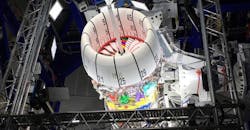Rolls-Royce and Altair Collaboration Leverages AI
Altair and Rolls-Royce Germany recently announced a strategic collaboration to address a wide variety of use cases focused on applying data science to vast amounts of engineering test data.
“We share a common vision on the convergence of AI and engineering to drive significant positive business outcomes. Altair has unique domain expertise and best-in-class, low-code data analytics technology. This collaboration will enable us to bridge the gap between engineering and data science, and empower our engineers to truly be engineers, focused on extracting the benefits of machine learning (ML) and artificial intelligence (AI) from our data,” said Dr. Peter Wehle, head of innovation and R&T, Rolls-Royce Deutschland. “Ultimately, this collaboration will help to democratize our data analytics, enable our engineers to make better daily data-driven decisions, and transform our business and products.”
Like many progressive manufacturers, Rolls-Royce works with large amounts of expensive data, and the use of AI and advanced data analytics have been at the heart of its business for more than 20 years. As part of its IntelligentEngine vision, this collaboration aims to connect AI and engineering even closer to derive business value.
While Altair already provides Rolls-Royce with numerous standard engineering tools including Hyperworks (FEA Pre/Post) and Optistruct (topology optimization), it came up with a disruptive meshless structural analysis tool (Simsolid) and added a range of data analytics tools to its portfolio. The next step shall be to connect those tools to unlock the full potential for extremely fast and deep insights into the structural system behavior.
Connecting structural engineering and data analytics will help to transform the development process, explains Wehle. “Technically, our long-term vision is to build a system-level design recommender system. Practically, we would like to give the non-data scientist engineers access to data science methods within a software environment they can work in and that can be maintained,” says Wehle.
Initially, Rolls-Royce will leverage Altair's Knowledge Works to enable engineers to apply machine learning (ML) methods utilizing simulation data, test data, manufacturing data, and operational data. Knowledge Works is designed so users can easily and efficiently access disparate data sources and formats in a low code/no-code environment, transform the data, use it to build ML models, and share knowledge discovery across the business.
The collaboration is also about allowing engineers to be engineers—creating a low code environment where engineers can effectively leverage data to realize meaningful insights without a deep data science background. “With this convergence of simulation and AI, we are actually providing these tools in a single pane of glass allowing engineers to drag and drop tools in order to further use models for the predictions and the validations of their design,” Altair CTO Sam Mahalingam says.
Empowering the Design Process
Successfully navigating the design process is crucial when bringing any new product to market. Unfortunately, a lot of important information is not available during the design concept phase. “As a result, decisions are based on the rules that have been defined as well as years of expertise,” says Mahalingam. “The lack of information during the concept design phase means a lot of iteration needs to take place, as a product enters into the detail design phase. This process leads to prolonged engine design lifecycle, often taking 10 years.”
Rules and lessons learned over decades have traditionally guided the decision-making process at this stage, adds Wehle. “Tools like risk reviews or failure mode analyses with experienced engineers play an essential role. Extensive simulation and test campaigns produce vast amounts of very detailed and complex data. Particularly during these phases, the engineering work reaches a peak resource consumption,” says Wehle. “As this information becomes available late in the process, much of this valuable data cannot be used for design improvements directly. Equally, highly valuable production and in-service data that characterize the real product behavior become available once the product is in regular service.”
Often, there is a general conflict where valuable data is both complex and late. “Ideally, we would like to have it much earlier and as simple information. Having more of that information available early in the process should enable us to run less and more effective testing and analysis,” says Wehle. “The growing demand for innovative solutions in short time scales also drives the need for a cultural change in the way engineering works.”
Rolls-Royce is helping make that cultural shift by using its data innovation catalyst, R2 Data Labs, to support each of the business units to unlock the value in data own. This includes its Digital Academy, which trains people across the business in digital skills, such as having an agile mindset, which can adapt and pivot to downstream challenges during a project. “From an artificial intelligence ethics and trustworthiness perspective, we also use our breakthrough Aletheia Framework toolkit, which scrutinizes the application of an AI to ensure it is ethical, and also controls bias by a five-step checking process on the decision made by an AI,” says Wehle. “This allows us to trust its activities and demonstrate they are ethical and is something we have published for free for anyone to use in any AI context.”
A significant goal is to bring the three different types of disparate data available to the design engineer, explains Mahalingam. “This includes historical data of all of the physics-based simulations from past designs, physical lab test feedback, and real-time operating data captured while an engine is in service,” he says. “The challenge is determining how to bring all of this disparate information together, so the initial design concept does not require so many iterations. This is where building a data-driven machine learning model can yield predictions to influence and validate the design at the concept phase itself.”
It is equally important to be able to create machine learning models that will work for varying types of engineering domains. “The structural use cases are different from the computational fluid dynamics use cases, and the same machine learning model will not work for all the different domains,” says Mahalingam. “This is where Altair and Rolls-Royce are really working together to make this happen.”
Selecting Use Cases
Data science techniques like classification, regression, clustering association rule discovery or anomaly detection, in general, are powerful tools for discovering knowledge from large datasets. The starting point of any Knowledge Discovery in Data (KDD) process is a situation where there is rich data (tremendous amounts of data stored in information repositories) and poor information (high-level summaries important for decision makings are hidden in a large amount of data).
“The exploration and analysis of large quantities of data in order to discover meaningful patterns and rules is closing the gap between data and information. The goal of applying this approach to the engineering development process shall be to make as much useful information available as early as possible. Along with that complex data shall be turned into simple and useful information that is available when needed,” says Wehle. “A combination of simple ‘Wise Rules’ and super-fast simulation techniques might allow for early identification of aspects relevant for the design. Those shall combine knowledge from various disciplines. Only that in-depth understanding can lead to true robust designs as well as cost-effective and fast development campaigns—actually, this means doing the right things.”
“The use cases that we are going to work with Rolls-Royce on are truly going to benefit us in terms of making sure that we pick the right data science, algorithm or use cases as we evolve to provide AI-based models,” says Mahalingam. “It also involves that whole knowledge we will automatically be providing so design engineers don't have to get out of that single pane of glass kind of an experience to augment machine learning into the validation phase.”
Adds Wehle, “Consequent use of data using data science techniques, therefore, will actually be the enabler for better products in shorter time scales. In many cases asking the right questions is helping to see how data analytics can help with simplifying the engineering process.”
The Right Questions
Can my product operate in a different mission? – “Often existing or similar products shall be operated in environments they were not originally developed for,” says Wehle. “Chaotic combinations of artificial mission assumptions can be turned into generic rules. Those again can be used to understand if a product is good to go or what needs to change. Complexity reduction using models with many input parameters can give a precise understanding of driving factors and limits.”
What causes the highest stresses? – “Typically, high effort is needed to calculate vast amounts of load combinations to find the sizing stress condition,” says Wehle. “What if we could know upfront which of those combinations are relevant. Decision tree classifiers are particularly powerful as they are intuitively understandable. In fact, they can be used in a technical discussion with pen and paper. Simple rules that can help to see the wood through the trees.”
Could each part know how strong it is? – “Why not? Smart Engine Components can learn quite a bit about their component performance, reserve factors or material usage,” says Wehle. “They can give immediate answers or recommendations on what needs to change in their design or the environment. Data analysis techniques in combination with classical engineering tools are a powerful combination to focus on the right questions at the right point in time.”
About the Author
Peter Fretty
Managing Editor
As a highly experienced journalist, Peter Fretty regularly covers advances in manufacturing, information technology, and software. He has written thousands of feature articles, cover stories, and white papers for an assortment of trade journals, business publications, and consumer magazines.



